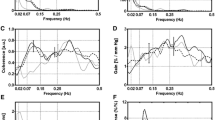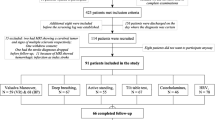Abstract
Objective
To investigate cardiovascular responses to orthostatic stress in patients with cerebrovascular accidents (CVA).
Methods
Twelve male patients with CVA, 11 healthy elderly and 12 healthy young males participated in the present study. The CVA patients had suffered stroke with hemiplegia at least 11 months prior to the study, their medical conditions were stable, and no subjects were taking medications affecting the cardiovascular system. Heart rate (HR) was determined using RR intervals from the ECG. Stroke volume (SV) was estimated by an impedance method, and cardiac output (CO) was calculated by multiplying SV by HR. Blood pressure (BP) was determined by the auscultatory method. SV, HR, CO and BP were measured every 2 min before and during 7 min of 60-degree head-up tilt (HUT).
Results
SV decreased and HR increased immediately after starting HUT in all groups. CO in healthy elderly and young subjects immediately decreased during HUT also, and the decrease was sustained throughout the head-up period. However, CO in CVA patients remained constant throughout the experiment. HUT immediately decreased SBP in all groups and the magnitude of initial SBP reduction in CVA patients was greater than that in the other groups.
Conclusions
We identified an initial reduction of BP during HUT in CVA patients and the recovery of BP by 3 min of head-up tilt. We emphasize that adjustment to orthostatic stress in CVA patients should be practiced by HUT, as our findings showed that CVA patients maintained physiological orthostatic tolerance except for the initial fall in BP.
Similar content being viewed by others
References
Rowell LB. Human cardiovascular control. New York: Oxford: 1993.
American Physiological Society. Handbook of physiology. In: Goodman HM, editors. Section 7. The Endocrine System. In: McEwen BS, editors, Volume IV. Coping with the environmental: neural and endocrine mechanisms. New York: Oxford; 2001.
Van Ouwenaller C, Laplace PM, Chantraine A. Painful shoulder in hemiplegia. Arch. Phys. Med. Rehabil. 1986; 67: 23–26.
Braus DF, Krauss JK, Strobel J. The shoulder-hand syndrome after stroke: a prospective clinical trial. Ann. Neurol. 1994; 36: 728–733.
Dursun E, Dursun N, Ural CE, Cakci A. Glenohumeral joint subluxation and reflex sympathetic dystrophy in hemiplegic patients. Arch. Phys. Med. Rehabil. 2000; 81: 944–646.
Lane RD, Wallace JD, Petrosky PP, Schwartz GE, Gradman AH. Supraventricular tachycardia in patients with right hemisphere strokes. Stroke 1992; 23: 362–366.
Barron SA, Rogovski Z, Hemli J. Autonomic consequences of cerebral hemisphere infarction. Stroke 1994; 25: 113–116.
Natelson BH. Neurocardiology. An interdisciplinary area for the 80s. Arch. Neurol. 1985; 42: 178–184.
Oppenheimer SM, Cechetto DF, Hachinski VC. Cerebrogenic cardiac arrhythmias. Cerebral electrocardiographic influences and their role in sudden death. Arch. Neurol. 1990; 47: 513–519.
Talman WT, Kelkar P. Neural control of the heart. Central and peripheral. Neurol. Clin. 1993; 11: 239–256.
Mizushima T, Tajima F, Nakamura T, Yamamoto M, Lee KH, Ogata H. Muscle sympathetic nerve activity during cold pressor test in patients with cerebrosvascular accidents. Stroke 1998; 29: 607–612.
Asberg KH. Orthostatic to lerance training of stroke patients in general medical wards. An experimental study. Scand. J. Rehabil. Med. 1989; 21: 179–185.
Hirschberg GG. Ambulation and self-care are goals of rehabilitation after stroke. Geriatrics 1976; 31: 61–65.
Dittmer DK, Teasell R. Complications of immobilization and bed rest. Part 1: Musculoskeletal and cardiovascular complications. Can. Fam. Physician. 1993; 39: 1428–1432, 1435–1437.
Coletta EM, Murphy JB. The complications of immobility in the elderly stroke patient. J. Am. Board. Fam. Pract. 1992; 5: 389–397.
Pavy-Le Traon A, Louisy F, Vasseur-Clausen P, Guell A, Gharib C. Contributory factors to orthostatic intolerance after simulated weightlessness. Clin. Physiol. 1999; 19: 360–368.
Di Girolamo E, Di Iorio C, Leonzio L, Sabatini P, Barsotti A. Usefulness of a tilt training program for the prevention of refractory neurocardiogenic syncope in adolescents: A controlled study. Circulation 1999; 100: 1798–1801.
Mahoney FI, Barthel DW. Functional evaluation: The Barthel index. Mateland State. Med. J. 1965; 14: 61–65.
van Swieten JC, Koudstaal PJ, Visser MC, Schouten HJ, van Gijn J. Interobserver agreement for the assessment of handicap in stroke patients. Stroke 1988; 19: 604–607.
Shiraki K, Konda N, Sagawa S, Lin YC, Hong SK. Cardiac output by impedance cardiography during heald-out water immersion. Undersea Biomed. Res. 1986; 13: 247–256.
Kubicek WG, Kottke FJ, Ramos MU, Patterson RP, Witsoe DA, Labree JW, et al. The Minnesota impedance cardiographtheory and applications. Biomed. Eng. 1974; 9: 410–416.
Snedecor GW, Cochran WG. Statistical Methods. 8th ed. Ames (IA): Iowa State University Press: 1989.
Sagawa S, Shiraki K, Miki K, Tajima F. Cardiovascular responses to upright tilt at a simulated altitude of 3,700 m in men. Aviat Space Environ. Med. 1993; 64: 219–223.
LaManca JJ, Peckerman A, Walker J, Kesil W, Cook S, Taylor A, et al. Cardiovascular response during head-up tilt in chronic fatigue syndrome. Clin. Physiol. 1999; 19: 111–120.
Colier WN, Binkhorst RA, Hopman MT, Oeseburg B. Cerebral and circulatory haemodynamics before vasovagal syncope induced by orthostatic stress. Clin Physiol. 1997; 17: 83–94.
Schondorf R, Benoit J, Wein T. Cerebrovascular and cardiovascular measurements during neurally mediated syncope induced by head-up tilt. Stroke 1997; 28: 1564–1568.
Ganong WF. Cardiovascular regulatory mechanism. East Norwalk (CT): Simon & Schuster; 1995.
Vargas E, Lye M. Physiological responses to postural change in young and old healthy individuals. Exp. Gerontol. 1982; 17: 445–451.
Shiraki K, Sagawa S, Yousef MK, Konda N, Miki K. Physiological responses of aged men to head-up tilt during heat exposure. J. Appl. Physiol. 1987; 63: 576–581.
Taylor JA, Hand GA, Johnson DG, Seals DR. Sympathoadrenal-circulatory regulation of arterial pressure during orthostatic stress in young and older men. Am. J. Physiol. 1992; 263: R1147-R1155.
Olsen H, Vernersson E, Lanne T. Cardiovascular response to acute hypovolemia in relation to age. Implications for orthostasis and hemorrhage. Am. J. Physiol. 2000;278: H222–232.
Lakatta EG. Cardiovascular aging in health. Clin. Geriatr. Med. 2000; 16: 419–443.
Tsutsui Y, Sagawa S, Yamauchi K, Endo Y, Yamazaki F, Shiraki K. Cardiovascular responses to lower body negative pressure in the elderly: role of reduced leg compliance. Gerontology 2002; 48: 133–139.
Ebert TJ, Hughes CV, Tristani FE, Barney JA, Smith JJ. Effect of age and coronary heart disease on the circulatory responses to graded lower body negative pressure. Cardiovasc. Res. 1982; 16: 663–669.
Minson CT, Wladkowski SL, Pawelczyk JA, Kenney WL. Age, splanchnic vasoconstriction, and heat stress during tilting. Am. J. Physiol. 1999; 276: R203-R212.
Author information
Authors and Affiliations
Corresponding author
Rights and permissions
About this article
Cite this article
Enishi, K., Tajima, F., Akimoto, H. et al. Initial drop of blood pressure during head-up tilt in patients with cerebrovascular accidents. Environ Health Prev Med 9, 228–233 (2004). https://doi.org/10.1007/BF02898104
Received:
Accepted:
Issue Date:
DOI: https://doi.org/10.1007/BF02898104




